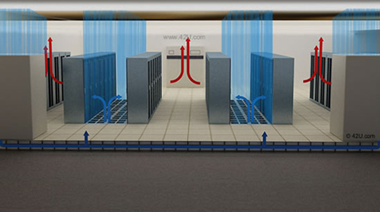Menu
- 130 King Street West, Suite 1800
- P.O. Box 427
- Toronto, ON, Canada M5X 1E3
- (416) 865-3392
- info@triparagon.com
Cooling accounts for about half a data center’s energy consumption, so improving the efficiency of your cooling infrastructure is critical for improving overall efficiency. One often-overlooked way to achieve this is by optimizing airflow.
Bypass airflow is air that does not pass through and cool IT equipment before returning to a cooling unit, and it should be kept to the absolute minimum. On average, about 60% of cold supply air does not reach the intake of IT equipment.

Some of the best ways to reduce bypass airflow include:
Blanking panels. Blanking panels are a low-cost solution that improves airflow, decreases server inlet temperatures, and increases return air temperatures. Panels alone can reduce energy costs by 1-2%. Don’t forget to plug up holes such as open U spaces, spaces between rails and edges of cabinets, and under cabinets.

Raised floor. Perforated tiles should be placed on the raised floor in front of IT equipment that requires cooling. Use grommets in the raised floor to seal cable penetrations and allow for maximum pressure to be maintained under the floor.
High-flow cabinet doors. Perforated cabinet doors improve airflow compared to doors made of glass or similar materials.

Efficiency hoods. Efficiency hoods for your CRAC units allow them to receive warmer air by extending your unit up to the return plenum. Pulling the hottest air possible out of the data center causes the temperature to get cooler and to cool quicker. Hoods can increase the capacity of cooling units by up to 25% and allow CRACs to cycle off more frequently, extending their lifespan.

Sealing the openings in the raised floor that release bypass airflow increases the volume of conditioned air from perforated tiles and grates. This will likely eliminate hot spots and increase the IT load that can be cooled, however, the return air temperature to cooling units will not change. The return air temperature to cooling units, and therefore their efficiency and capacity, is a function of airflow volume, heat load, and the thermostatically controlled return air temperature set points of the units. Raising the cooling unit return air temperature set points increases the efficiency and capacity of cooling units.
Containment can be conducive to bypass airflow. How can that be? What is the one element of a containment facility that remains open between the supply side and the return side? The servers, of course. Published studies of containment research projects and experiments indicate that servers can be a conduit for significant bypass airflow. This is especially true for comatose servers, but even operating servers can have their fans over-spun by too dramatic pressure differentials between hot and cold sides. The potential for a pressure-driven bypass through the IT equipment will be greater for cold aisle containment, just by the limited available mass, so pressure differential control methodology and discipline need to become part of the overall management toolkit. The effect of this bypass path will be everything previously discussed.

The causes of bypass airflow are relatively well understood in the industry, and airflow management vendors offer a plethora of solutions to abate bypass airflow. A clear understanding of the effects of bypass should clarify why we spend so much time talking about causes and cures.